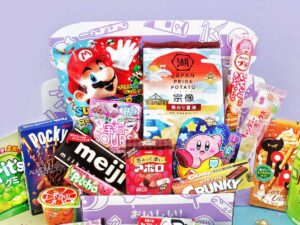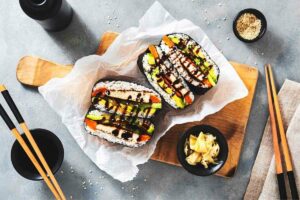Onigiri are a Japanese dish made of rice formed into triangular or oval shapes and filled with various ingredients.
Onigiri are often served as a snack, but can also be a light meal.
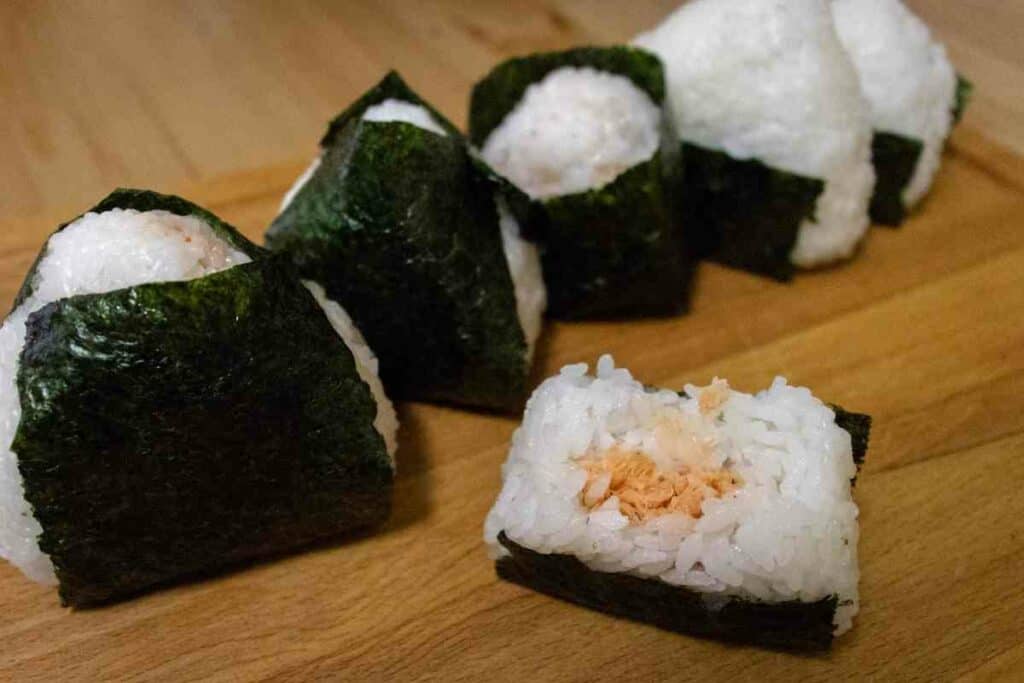
Vegetarian onigiri fillings can be just as delicious as meat-based fillings, and they offer a great way to get protein and other nutrients while avoiding meat.
Here is a list of vegetarian onigiri filling ideas.
Table of Contents
Individual Ingredients
Adding one ingredient to your onigiri filling is an expeditious way to flavor it without adding a lot of effort.
Vegetables
As a vegetarian, you probably already eat a lot of vegetables.
But did you know that they also make great onigiri fillings?
One of the most popular vegetable onigiri fillings is pickled plum (umeboshi).

Other popular choices include shredded carrot, daikon radish, cucumber, and kimchi.
You can add just about any vegetable you’d like to onigiri:
- eggplant
- edamame
- bell pepper
- mushrooms
- spinach
- broccoli
- ginger
- bean sprouts
- cabbage
- onions
- pumpkin
- squash
The list could go on until all the vegetables have been named, but you get the idea.
You can also use each vegetable in several different ways to change up the flavors and textures.
You can bake, fry, steam, or sauté your vegetables before adding them to the onigiri.
Umeboshi
Umeboshi is a pickled plum.
It has a salty and very sour taste to it, but you can find some sweet umeboshi.
Making umeboshi is a month-long process that you can do in the summer. Around mid-June, pick up yellow ume when they start to appear in stores.
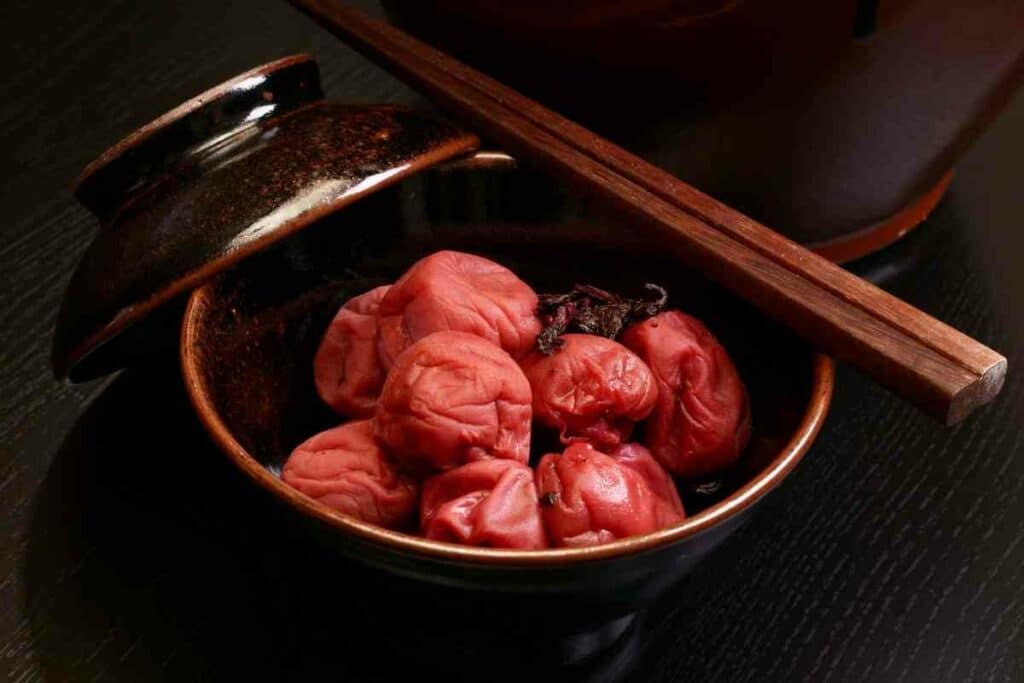
You may need to find a specialty market to find ume, but if you have a Japanese or Asian market near you, they will most likely carry it.
Then add the ume to a container with a lid and completely cover them in salt for a week.
When red shisho leaves are available at the end of June, add them to the container to give the ume a naturally dyed red color.
In mid-July – Wait until a day with no forecasted rain for three days. You need 3 full dry days to finish the last step. When you know it is going to be dry, remove the ume from the container and put them on a tray in the sun to dry out.
Kombu
Kombu is a type of kelp that is often used in Japanese cuisine.
It has a salty and slightly fishy flavor.
There are a few different ways kombu is sold. You can find it dried or dehydrated, pickled, dried and shredded, or even fresh.
Natto
Natto is a type of fermented soybean.
It has a strong and distinct flavor that some people love and others can’t stand.
If you’ve never had natto before, it might be best to start with a small amount to see if you like it before adding it to your onigiri filling.
Natto is usually sold in small packs with soy sauce and mustard included. These can be found in the refrigerated section of Japanese or Asian markets.
Seeds and Nuts
You can also take seeds or nuts and turn them into a paste (or just add them whole) to your onigiri.
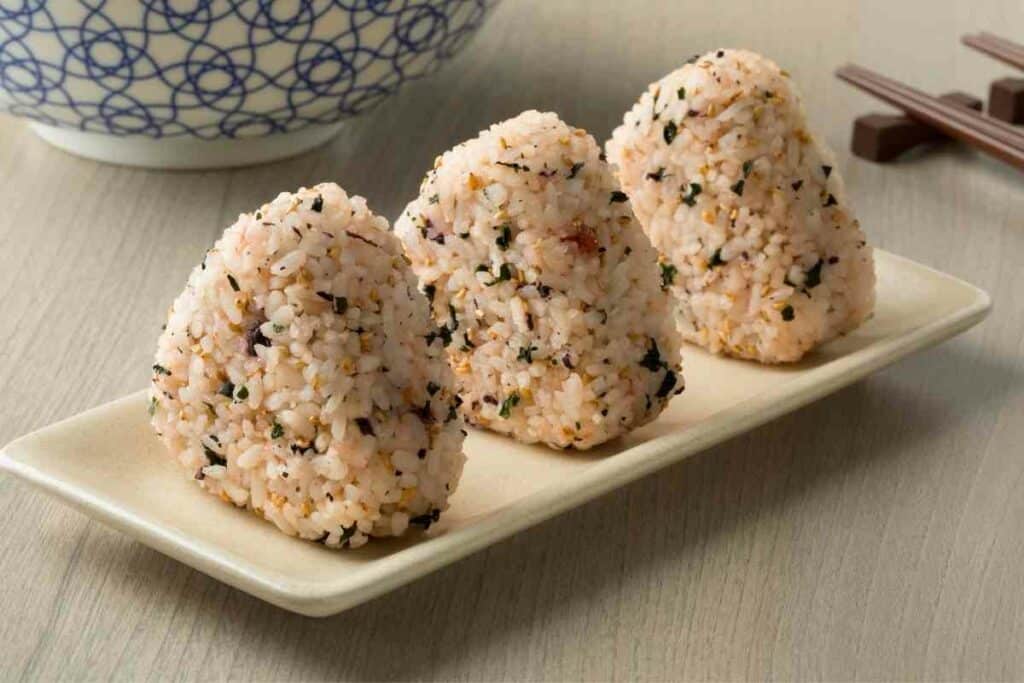
Some of the best and most flavorful are:
- peanuts
- Ginko nuts
- cashews
- sesame seeds
- pumpkin seeds
Cheese
Cheese isn’t the first thing that comes to mind when you think of Asian cuisine, but if you’re looking for delicious comfort food, consider cheese as a vegetarian-friendly onigiri filling.
Make small cubes of your favorite cheese and coat them in sticky rice.
You can eat them plain or you can elevate your onigiri by frying or baking them to melt the cheese.
Enhancing Single Ingredients
All of those ingredients are fine on their own, but what if you could enhance the flavor with only one other ingredient?
The benefits of a tasty onigiri filling and still not taking a lot of time to make.
There are three things you can do to your onigiri that won’t take much time at all.
Seasoning
Add spice to your onigiri to enhance the flavor.
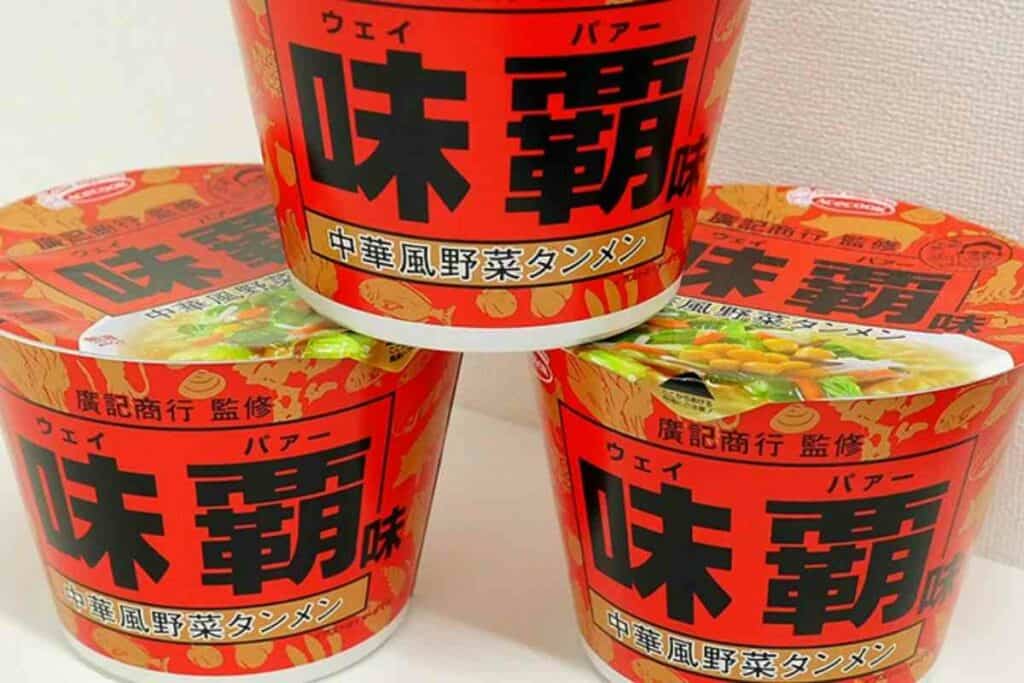
You can use any from this list, or any that you have in your cupboards:
- salt
- pepper
- cayenne
- chili powder
- cumin
- garlic powder
- onion powder
- paprika
- wasabi powder
Sauce
You can also add sauces to your fillings to add a lot of flavors quickly.
Sauces don’t need to be limited to savory, you can also have sweet.
This list will give you plenty of sauce ideas:
- Soy sauce
- Fish sauce
- Sesame oil
- Miso paste
- BBQ sauce
- Honey garlic sauce
- Honey
- Agave nectar
- Maple syrup
The key is to not add too much sauce or you risk the chance of it leaking through the sticky rice and making the onigiri fall apart.
Vegetarian Onigiri Filling Recipes
If you want the most flavor, it’ll take a little bit of work but the onigiri you’re left with at the end will be worth the effort.
Nitamago
This one might be controversial for some vegetarians.
Some claim you shouldn’t eat eggs if you are vegetarian, and others believe it is fine.
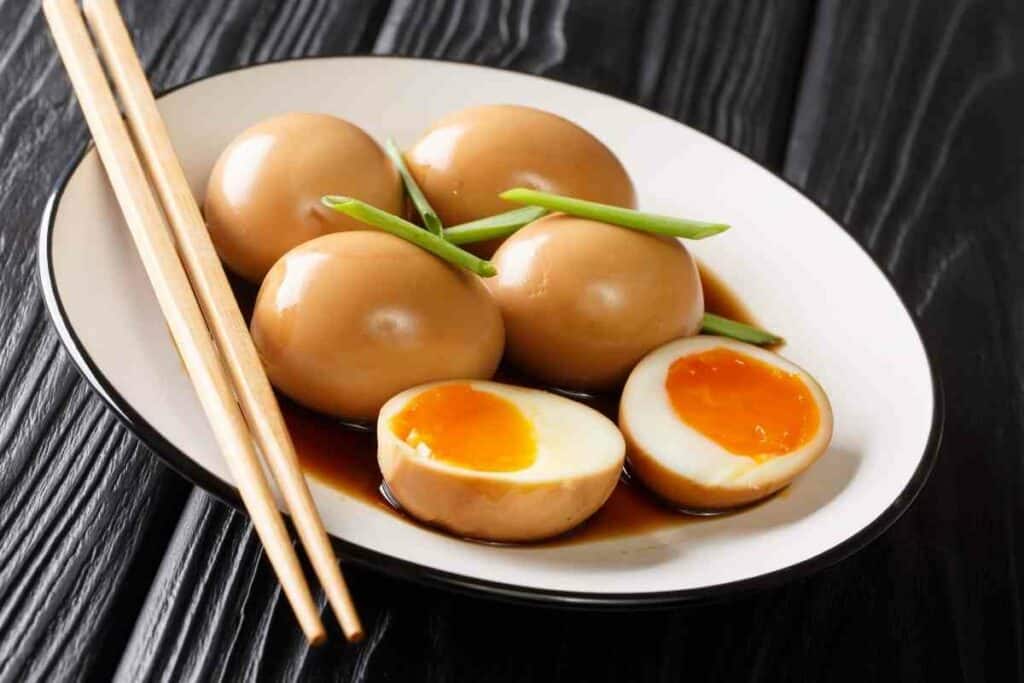
This recipe is too good not to share but you can avoid trying it if it makes you uncomfortable.
You will need to gather these ingredients:
- 5 tablespoons tsuyu sauce
- 5 teaspoons soy sauce
- 5 tablespoons water
- 5 teaspoons mirin
- 2 teaspoons sake
- 1 teaspoon sugar
- 1 Pot of water
- 4-6 eggs
- 1 teaspoon salt
- 1 bowl of ice-cold water
And now for the instructions.
- Start by soft boiling your eggs. Bring the pot of water to a boil, insert the eggs, and let them boil for 6 to 7 minutes.
- Take the eggs out of the boiling water and put them in the ice water. This slows the cooking process so they don’t continue cooking.
- In a small pan, add the tsuyu sauce, soy sauce, water, mirin, sake, and sugar. Cook over medium heat while stirring frequently until it boils. Let it boil for 2 minutes and then remove it from heat.
- By this point, your eggs should be relatively cool. You should be able to peel them without burning your fingers.
- Once your sauce is made and eggs are peeled, put them in a Ziploc bag together and let them marinate in the fridge for at least half an hour. The longer they marinate the better they’ll taste.
Now all that’s left is to cover each egg in sticky rice and you have Nitamago onigiri.
Negi Miso Filling
This filling combination doesn’t require any cooking, just gathering, chopping, and mixing.
You’ll need:
- 1 teaspoon sesame oil
- 2 tablespoons miso paste
- 1 green onion
- 3/4 teaspoon ginger paste (or 1 teaspoon finely minced ginger)
- 1/4 teaspoon sugar
- 1 1/2 tablespoons mirin
- 1/2 tablespoon sesame seeds
- 1/4 teaspoon soy sauce
Combine all the ingredients in a bowl, and use the mixture to fill your onigiri.
Nori Tsukudani
Tsukudani is usually made with seafood, but nori tsukudani gets its flavor from seaweed making this an excellent vegetarian spin on a classic.
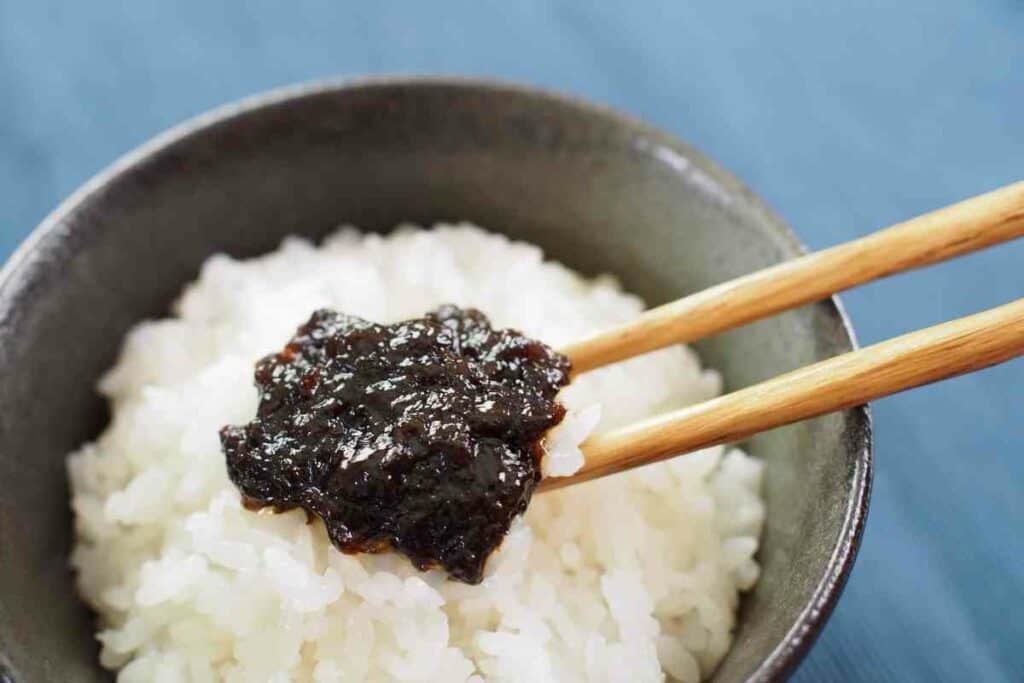
For this filling you’ll need:
- 10 nori sheets (roasted seaweed)
- 2 cups dashi
- 1/4 cup soy sauce
- 1/4 cup sake
- 2 tablespoons mirin
You will have to cook the filling to thicken it to make a suitable paste, but it is fairly easy.
- Tear the nori into small pieces and add it to a pot with dashi.
- Cook the nori and dashi over medium heat stirring constantly for 5 minutes or until thick.
- Add the soy sauce, sake, and mirin.
- Reduce the heat and let the mixture simmer until most of the liquid is gone and you’re left with an almost gel-like paste.
Vegan Tuna Filling
This onigiri filling is a vegetarian version of traditional tuna filling.
It has a similar taste, color, and texture to tuna, and it still has plenty of protein.
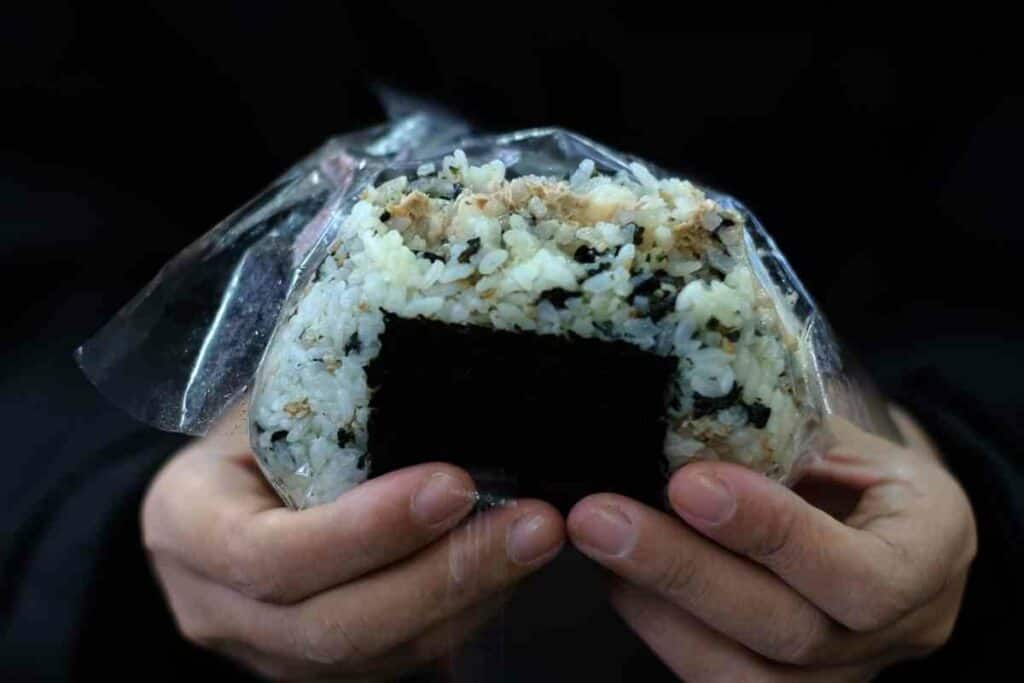
The ingredients you need are:
- 1/4 cup cooked chickpeas
- 1/2 tablespoon soy sauce
- 1/2 tablespoon rice vinegar
- 1/4 teaspoon garlic powder
- 1/2 an avocado
- 1 nori sheet
Follow the process:
- Start by turning the chickpeas into a paste. You can do this with a blender, a food processor, or a wooden spoon.
- Add the soy sauce, rice vinegar, and garlic powder. Stir until combined.
- To get the fishy flavor, rip the nori into tiny pieces or blend it in a food processor and add it to the mix.
- If the mixture doesn’t look creamy, add a splash of water and mix until it has the right texture.
Final Thoughts
Onigiri are a delicious and versatile food that can be filled with many different types of vegetarian-friendly ingredients.
Several of the best-tasting onigiri fillings have been listed, but feel free to be as creative or simple as you’d like when it comes to the filling for onigiri.
- Japanese Traditional Sweets (Wagashi): A Guide to Their Origins and Varieties
- A Taste of Japan in Every Bite – Japanese Candy & Snack Box Review
- Bubble Tea vs Boba Compared: What’s the Difference?
- Best Izakaya Foods for a Relaxed Night Out (My Top 10 Picks)
- Edo Kiriko Whiskey Glasses (Japanese Heritage in Every Pour)
- Japanese Viral Foods on Social Media (Discover the Top 10)


